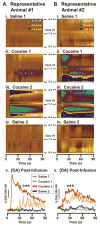Rapid induction of dopamine sensitization in the nucleus accumbens shell induced by a single injection of cocaine
- PMID: 28223145
- PMCID: PMC5346451
- DOI: 10.1016/j.bbr.2017.02.018
Rapid induction of dopamine sensitization in the nucleus accumbens shell induced by a single injection of cocaine
Abstract
Repeated intermittent exposure to cocaine results in the neurochemical sensitization of dopamine (DA) transmission within the nucleus accumbens (NAc). Indeed, the excitability of DA neurons in the ventral tegmental area (VTA) is enhanced within hours of initial psychostimulant exposure. However, it is not known if this is accompanied by a comparably rapid change in the ability of cocaine to increase extracellular DA concentrations in the ventral striatum. To address this question we used fast-scan cyclic voltammetry (FSCV) in awake-behaving rats to measure DA responses in the NAc shell following an initial intravenous cocaine injection, and then again 2-h later. Both injections quickly elevated DA levels in the NAc shell, but the second cocaine infusion produced a greater effect than the first, indicating sensitization. This suggests that a single injection of cocaine induces sensitization-related plasticity very rapidly within the mesolimbic DA system.
Keywords: Cocaine; Dopamine; Nucleus accumbens; Psychostimulant; Sensitization; Voltammetry.
Copyright © 2017 Elsevier B.V. All rights reserved.
Conflict of interest statement
There are no perceived conflicts of interest to report
Figures


Similar articles
-
Terminal Dopamine Release Kinetics in the Accumbens Core and Shell Are Distinctly Altered after Withdrawal from Cocaine Self-Administration.eNeuro. 2016 Oct 6;3(5):ENEURO.0274-16.2016. doi: 10.1523/ENEURO.0274-16.2016. eCollection 2016 Sep-Oct. eNeuro. 2016. PMID: 27752541 Free PMC article.
-
Differential regulation of the mesoaccumbens dopamine circuit by serotonin2C receptors in the ventral tegmental area and the nucleus accumbens: an in vivo microdialysis study with cocaine.Neuropsychopharmacology. 2008 Jan;33(2):237-46. doi: 10.1038/sj.npp.1301414. Epub 2007 Apr 11. Neuropsychopharmacology. 2008. PMID: 17429406
-
Repeated ventral tegmental area amphetamine administration alters dopamine D1 receptor signaling in the nucleus accumbens.Synapse. 2002 Sep 1;45(3):159-70. doi: 10.1002/syn.10095. Synapse. 2002. PMID: 12112395
-
Hypocretin receptor 1 involvement in cocaine-associated behavior: Therapeutic potential and novel mechanistic insights.Brain Res. 2020 Mar 15;1731:145894. doi: 10.1016/j.brainres.2018.07.027. Epub 2018 Jul 30. Brain Res. 2020. PMID: 30071195 Review.
-
Roles of dopamine and glutamate co-release in the nucleus accumbens in mediating the actions of drugs of abuse.FEBS J. 2021 Mar;288(5):1462-1474. doi: 10.1111/febs.15496. Epub 2020 Aug 11. FEBS J. 2021. PMID: 32702182 Free PMC article. Review.
Cited by
-
An integrated microfluidic and fluorescence platform for probing in vivo neuropharmacology.Neuron. 2025 May 21;113(10):1491-1506.e6. doi: 10.1016/j.neuron.2025.03.017. Epub 2025 Apr 10. Neuron. 2025. PMID: 40215966
-
Cocaine Effects on Dopaminergic Transmission Depend on a Balance between Sigma-1 and Sigma-2 Receptor Expression.Front Mol Neurosci. 2018 Feb 12;11:17. doi: 10.3389/fnmol.2018.00017. eCollection 2018. Front Mol Neurosci. 2018. PMID: 29483862 Free PMC article.
References
-
- Robinson TE, Berridge KC. The neural basis of drug craving: an incentive-sensitization theory of addiction. Brain Res Brain Res Rev. 1993;18:247–91. - PubMed
-
- Vezina P. Sensitization of midbrain dopamine neuron reactivity and the self-administration of psychomotor stimulant drugs. Neurosci Biobehav Rev. 2004;27:827–39. - PubMed
-
- Grignaschi G, Burbassi S, Zennaro E, Bendotti C, Cervo L. A single high dose of cocaine induces behavioural sensitization and modifies mRNA encoding GluR1 and GAP-43 in rats. Eur J Neurosci. 2004;20:2833–2837. - PubMed
-
- Lin-Chu G, Robinson TE, Becker JB. Sensitization of rotational behavior produced by a single exposure to cocaine. Pharmacol Biochem Behav. 1985;22:901–3. - PubMed
Publication types
MeSH terms
Substances
Grants and funding
LinkOut - more resources
Full Text Sources
Other Literature Sources

